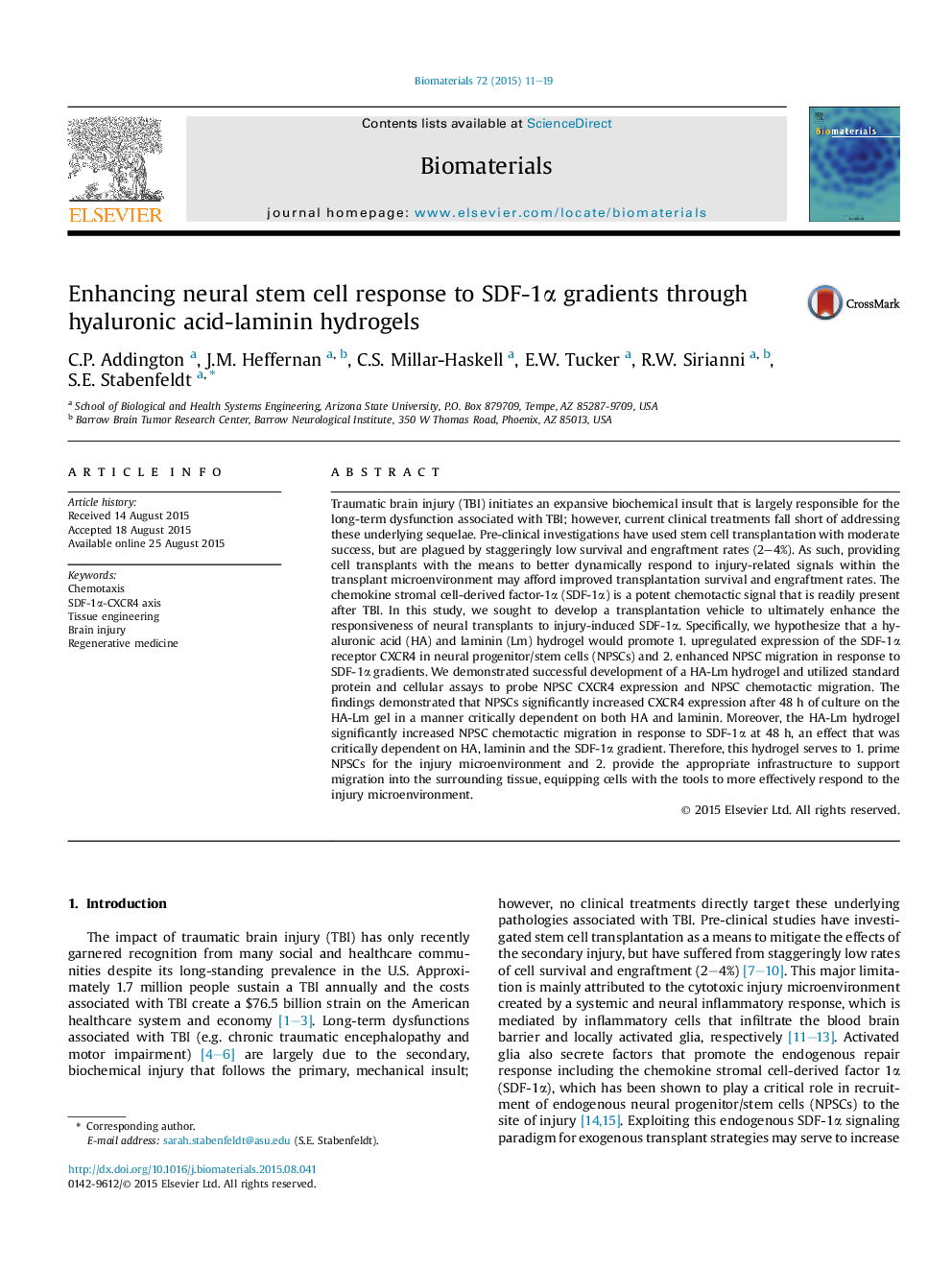| کد مقاله | کد نشریه | سال انتشار | مقاله انگلیسی | نسخه تمام متن |
|---|---|---|---|---|
| 6485389 | 398 | 2015 | 9 صفحه PDF | دانلود رایگان |
عنوان انگلیسی مقاله ISI
Enhancing neural stem cell response to SDF-1α gradients through hyaluronic acid-laminin hydrogels
دانلود مقاله + سفارش ترجمه
دانلود مقاله ISI انگلیسی
رایگان برای ایرانیان
کلمات کلیدی
موضوعات مرتبط
مهندسی و علوم پایه
مهندسی شیمی
بیو مهندسی (مهندسی زیستی)
پیش نمایش صفحه اول مقاله

چکیده انگلیسی
Traumatic brain injury (TBI) initiates an expansive biochemical insult that is largely responsible for the long-term dysfunction associated with TBI; however, current clinical treatments fall short of addressing these underlying sequelae. Pre-clinical investigations have used stem cell transplantation with moderate success, but are plagued by staggeringly low survival and engraftment rates (2-4%). As such, providing cell transplants with the means to better dynamically respond to injury-related signals within the transplant microenvironment may afford improved transplantation survival and engraftment rates. The chemokine stromal cell-derived factor-1α (SDF-1α) is a potent chemotactic signal that is readily present after TBI. In this study, we sought to develop a transplantation vehicle to ultimately enhance the responsiveness of neural transplants to injury-induced SDF-1α. Specifically, we hypothesize that a hyaluronic acid (HA) and laminin (Lm) hydrogel would promote 1. upregulated expression of the SDF-1α receptor CXCR4 in neural progenitor/stem cells (NPSCs) and 2. enhanced NPSC migration in response to SDF-1α gradients. We demonstrated successful development of a HA-Lm hydrogel and utilized standard protein and cellular assays to probe NPSC CXCR4 expression and NPSC chemotactic migration. The findings demonstrated that NPSCs significantly increased CXCR4 expression after 48 h of culture on the HA-Lm gel in a manner critically dependent on both HA and laminin. Moreover, the HA-Lm hydrogel significantly increased NPSC chemotactic migration in response to SDF-1α at 48 h, an effect that was critically dependent on HA, laminin and the SDF-1α gradient. Therefore, this hydrogel serves to 1. prime NPSCs for the injury microenvironment and 2. provide the appropriate infrastructure to support migration into the surrounding tissue, equipping cells with the tools to more effectively respond to the injury microenvironment.
ناشر
Database: Elsevier - ScienceDirect (ساینس دایرکت)
Journal: Biomaterials - Volume 72, December 2015, Pages 11-19
Journal: Biomaterials - Volume 72, December 2015, Pages 11-19
نویسندگان
C.P. Addington, J.M. Heffernan, C.S. Millar-Haskell, E.W. Tucker, R.W. Sirianni, S.E. Stabenfeldt,